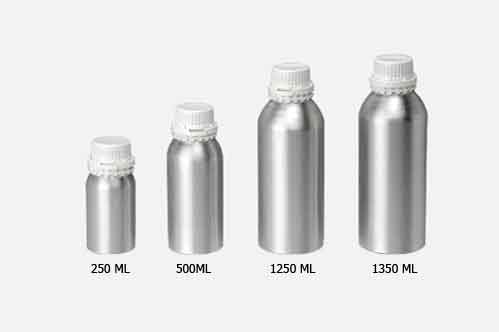Manufacturers of anodized aluminum containers, industrial aluminum containers, widemouth aluminum bottles, aluminum storage canisters, 10 litre and 25 litre aluminum containers, aluminum cans, aluminum jars, brush finished and anodized aluminum bottles with HDPE cap and Alloy caps.
The aluminum containers cater to the packaging needs in the flavors & fragrance, perfume, pesticide/agrochemical, fine chemicals, food and pharmaceuticals Industry.
These containers are highly durable and corrosion resistant. Customization of designs is also done.
Finish: Polished, Frosted, gold/silver anodized and brush finish
Mr. Balasubramaniam (Partner)
P. Gopal Chettiar Rolling Works Manufacturers of anodized aluminum containers
DP128 B, Phase II,
SIDCO Industrial Area, Vichoor,
Chennai – 600103,
Tamil Nadu, India
Mobile: 044 – 9444009162
Anodizing:
Anodizing is an electrolytic passivation process used to increase the thickness of the natural oxide layer on the surface of metal parts.
The process is called anodizing because the part to be treated forms the anode electrode of an electrolytic cell. Anodizing increases resistance to corrosion and wear, and provides better adhesion for paint primers and glues than bare metal does. Anodic films can also be used for several cosmetic effects, either with thick porous coatings that can absorb dyes or with thin transparent coatings that add interference effects to reflected light.
Anodizing is also used to prevent galling of threaded components and to make dielectric films for electrolytic capacitors. Anodic films are most commonly applied to protect aluminium alloys, although processes also exist for titanium, zinc, magnesium, niobium, zirconium, hafnium, and tantalum. Iron or carbon steel metal exfoliates when oxidized under neutral or alkaline micro-electrolytic conditions; i.e., the iron oxide (actually ferric hydroxide or hydrated iron oxide, also known as rust) forms by anoxic anodic pits and large cathodic surface, these pits concentrate anions such as sulfate and chloride accelerating the underlying metal to corrosion. Carbon flakes or nodules in iron or steel with high carbon content (high-carbon steel, cast iron) may cause an electrolytic potential and interfere with coating or plating. Ferrous metals are commonly anodized electrolytically in nitric acid or by treatment with red fuming nitric acid to form hard black Iron(II,III) oxide. This oxide remains conformal even when plated on wiring and the wiring is bent.
Anodizing changes the microscopic texture of the surface and the crystal structure of the metal near the surface. Thick coatings are normally porous, so a sealing process is often needed to achieve corrosion resistance. Anodized aluminium surfaces, for example, are harder than aluminium but have low to moderate wear resistance that can be improved with increasing thickness or by applying suitable sealing substances. Anodic films are generally much stronger and more adherent than most types of paint and metal plating, but also more brittle. This makes them less likely to crack and peel from ageing and wear, but more susceptible to cracking from thermal stress.
https://en.wikipedia.org/wiki/Anodizing
You may also be interested in

2 thoughts on “P. Gopal Chettiar Rolling Works”